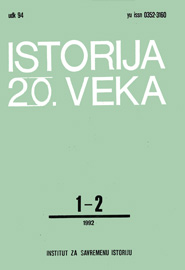DRŽAVNE GRANICE KRALJEVINE SRBA, HRVATA I SLOVENACA
STATE BORDERS OF THE KINGDOM OF THE SERBS, CROATS AND SLOVENIANS
Author(s): Toma MilenkovićSubject(s): Political history, Recent History (1900 till today), Pre-WW I & WW I (1900 -1919), Interwar Period (1920 - 1939), Geopolitics
Published by: Institut za savremenu istoriju, Beograd
Keywords: Kingdom of Yugoslavia; state borders; Paris peace conference; 1919; 1925; Italy;
Summary/Abstract: The author presents, in this work of synthetic character, the history of Yugoslavia's state borders at the time of the Paris Peace Conference. The situation on the state borders of Yugoslavia was then a very complex one because Yugoslavia bordered on a large number of countries. The Yugoslav delegation presented its demands regarding borders at the Peace Conference in the known Memorandum. Their criteria in this matter were based on ethnic, strategic, economic, historical and other factors. This study shows that the definite border between the Kingdom of the Serbs, Croats and Slovenians and Albania was determined only in April 1925. Sporadic negotiations went on in the meantime but there were also constant border skirmishes and larger military conflicts between the two countries. In the end, the border determined in 1913 was reinforced (with minor changes in Yugoslavia’s favor). This decision remained effective after the Second World War. The study shows how the Bulgarian army cut through the Morava -Vardar valley in 1915, taking advantage of the valley’s proximity to the Bulgarian border. In order to prevent this from being repeated in the future, the Conference took away from Bulgaria Strumičko Polje and the regions of Bosiljgrad and Caribrod, and moved the border to strategic positions in the east. As far as Romania is concerned, both the Romanian and the Yugoslav delegation at the Peace Conference made maximum demands regarding Banat. However, a compromise was reached by dividing Banat. In Bačka the border with Hungary remained for the most part at the point reached by the Serbian army and requested by the Yugoslav delegation. A great political battle had to be fought for Baranja so that one of its parts, populated mostly by Slavs, would go to Yugoslavia. The regional government in Ljubljana was rather passive in its politics regarding the border with Austria. The military actions it undertook in Koruška were mild and did not have the support of the local Slovenian population, lits military troops would seize certain territories without battle and would then lose them without putting up much of о struggle. Koruška was the only region in which a plebiscite was applied in this matter. In the plebiscite at the end of October 1920, most Slovenians of Koruška voted in favor of Austria so that nearly the whole region was lost. The state border determined at the time remained valid after the Second World War, Yugoslavia's greatest problems concerning borders were with Italy as the latter was one of the victorious allied countries and had a strong influence on the Peace Conference. Furthermore, the powers of the Entente had promised Italy large parts of Yugoslav territory by a secret treaty signed in London in 1915, in order to win it over to their side, Immediately after the war, the Italian army took possession of all the parts promised to Italy and more. Negotiations between Yugoslavia and Italy were very slow. The Agreement signed in Rapallo, on 12 November 1920, gave Italy a large part of Julijska Krajina, Primorska, the whole of Istria, the islands Cres, Lošinj and Lastovo and the city of Zadar. Rijeka with its surrounding regions was proclaimed an independent state. However, Italy constantly and successfully undermined the state of Rijeka and practically annexed it. By renewing pressure on Yugoslavia, Italy managed to gain formal recognition of the situation it had created by the Rome Agreement of January 1924, which gave Rijeka to Italy.
Journal: Istorija 20. veka
- Issue Year: 1992
- Issue No: 1+2
- Page Range: 9-25
- Page Count: 17
- Language: Serbian

